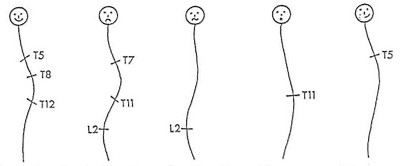Scoliosis is divided into simple C-shaped scoliosis (single curved) and S-shaped scoliosis when the spine curvatures go to different directions. Also the is E-shaped scoliosis or the total scoliosis with multiple spine distortions.
Scoliosis can be of dysplastic, scars, traumatic, myopathic or neurogenic origin.
Different Types Of Scoliosis Curves
– Cervico-thoracic scoliosis: the spine is curved at the level of 4-5 top spinal bones (neck area). It is accompanied by the early deformations in the chest (thoracic) area and the changes of the front side of the skeleton.
– Thoracic scoliosis (chest scoliosis): the level of 8-9 bones; there can be right and left curvatures.
– Lumbar-thoracic scoliosis: the first curve’s top level is at 10-11 vertebras (spinal bones).
– The lumbar scoliosis is at the level of 1-2 lumbar spinal bones; it usually progresses slowly, but in the area of spinal deformation the lower back pain often comes early.
– Combined, or S-shaped scoliosis is characterized by two primary arcs of curvature – at 8-9 and 1-2 thoracic lumbar vertebrae. In addition, the disease is also classified in the angle of curvature: the angle of the first degree is 1-10 °, the second – 11-25 °, the third – 26 ° -50 °, and the fourth – more than 50 °.
Scoliosis can also be fixed and non-fixed, disappearing in a horizontal position, such as shortening of one limb.
Along with scoliosis the rotation around the vertical axis of the spine is also observed. The rotation facilitates the deformation of the chest and its asymmetry, while the internal organs are compressed and displaced.
Types of Scoliosis According To the Causes
There is congenital scoliosis, which are based on various deformations of vertebrae: hypoplasia, the wedge shape of the spinal bones, additional vertebrae, etc.
Acquired scoliosis includes:
– Rheumatic fever usually occurs suddenly and is caused by muscle spasms on the healthy side of the spine in the presence of myositis or spondylitis.
– Rachitic scoliosis, which appears very early in the various deformations of the musculoskeletal system. The softness of the bones and the muscle weakness, carrying the baby in hands (mostly in the left hand), prolonged sitting, especially in school – all these factors are conducive to the manifestation and progression of scoliosis.
– Paralytic scoliosis often occurs after infantile paralysis, with a unilateral lesion of muscles, but can also be observed in other nervous diseases.
– Common scoliosis is caused by habitual poor posture (often referred to as “school”, because at this age, this type receives the highest expression). The immediate cause of it can be improperly arranged school desks, students are seated without any regard to their growth and desks rows, the wearing of the heavy school bags in the early grades, etc.
This list certainly does not cover all types of scoliosis, but only the main ones.
Information on scoliosis in children shows that it is one of the most common kids’ disorders; it left untreated, it progresses and reaches its full stage of advancement by the end for child’s body growth. SInce the severe spinal curvatures negatively affect the proper functioning of the internal organs it is advised that parents take care of the postures of their kids and if the first symptoms of scoliosis appear, take an immediate steps towards scoliosis treatment. But keep in mind that it is always better to avoid and prevent the occurrence of scoliosis in children.

